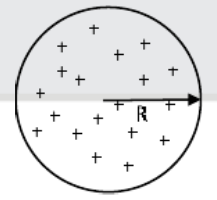Assertion: Electric potential on the surface of a charged sphere of radius R is V. Then electric field at distance r=R2 from centre is V2R. Charge is distributed uniformly over the volume.
Reason: From centre to surface, electric field varies linearly with r. Here r is distance from centre.
If both Assertion and Reason are true but Reason is the correct explanation of Assertion.
If both Assertion and Reason are true but Reason is not the correct explanation of Assertion.
If Assertion is true, but the Reason is false.
If Assertion is false but the Reason is true.
The correct Answer is:B
To solve the question, we need to analyze the assertion and the reason provided.
1. Understanding the Assertion:
- The assertion states that the electric potential V on the surface of a uniformly charged sphere of radius R leads to an electric field at a distance r=R2 from the center being V2R.
2. Electric Potential on the Surface:
- The electric potential V on the surface of a charged sphere is given by the formula:
V=kQR
where k is Coulomb's constant and Q is the total charge on the sphere.
3. Using Gauss's Law:
- To find the electric field E inside the sphere at a distance r=R2, we apply Gauss's Law:
ΦE=Qencϵ0
- The charge enclosed Qenc within a radius r (where r<R) is given by:
Qenc=ρ⋅Volume=ρ⋅43πr3
- The volume charge density ρ can be expressed as:
ρ=Q43πR3
- Substituting this into the expression for Qenc:
Qenc=Q43πR3⋅43πr3=Q⋅r3R3
4. Calculating Electric Field:
- Now, substituting Qenc into Gauss's Law:
E⋅4πr2=Q⋅r3R3ϵ0
- Rearranging gives:
E=Q4πϵ0R3⋅r
- This shows that the electric field E varies linearly with r.
5. Finding Electric Field at r=R2:
- Substituting r=R2:
E(R2)=Q4πϵ0R3⋅R2=Q8πϵ0R2
6. Relating Electric Field to Potential:
- From the potential V=kQR, we can express Q as:
Q=VRk
- Substituting this into our expression for E:
E(R2)=V2R
7. Conclusion:
- The assertion is true: the electric field at r=R2 is V2R.
- The reason provided states that the electric field varies linearly with r, which is also true, but it does not directly explain the assertion.
Final Answer:
- The assertion is true, and the reason is true but does not correctly explain the assertion.
- The assertion states that the electric potential V on the surface of a uniformly charged sphere of radius R leads to an electric field at a distance r=R2 from the center being V2R.
- The electric potential V on the surface of a charged sphere is given by the formula:
V=kQR
where k is Coulomb's constant and Q is the total charge on the sphere.
- To find the electric field E inside the sphere at a distance r=R2, we apply Gauss's Law:
ΦE=Qencϵ0
- The charge enclosed Qenc within a radius r (where r<R) is given by:
Qenc=ρ⋅Volume=ρ⋅43πr3
- The volume charge density ρ can be expressed as:
ρ=Q43πR3
- Substituting this into the expression for Qenc:
Qenc=Q43πR3⋅43πr3=Q⋅r3R3
- Now, substituting Qenc into Gauss's Law:
E⋅4πr2=Q⋅r3R3ϵ0
- Rearranging gives:
E=Q4πϵ0R3⋅r
- This shows that the electric field E varies linearly with r.
- Substituting r=R2:
E(R2)=Q4πϵ0R3⋅R2=Q8πϵ0R2
- From the potential V=kQR, we can express Q as:
Q=VRk
- Substituting this into our expression for E:
E(R2)=V2R
- The assertion is true: the electric field at r=R2 is V2R.
- The reason provided states that the electric field varies linearly with r, which is also true, but it does not directly explain the assertion.
- The assertion is true, and the reason is true but does not correctly explain the assertion.
Topper's Solved these Questions
- BOOK - DC PANDEY ENGLISHCHAPTER - ELECTROSTATICSEXERCISE - Level 1 Objective82videos
ELECTROSTATICS
- BOOK - DC PANDEY ENGLISHCHAPTER - ELECTROSTATICSEXERCISE - Level 1 Subjective15videos
ELECTROSTATICS
- BOOK - DC PANDEY ENGLISHCHAPTER - ELECTROSTATICSEXERCISE - Exercise 24.72videos
ELECTROSTATICS
- BOOK - DC PANDEY ENGLISHCHAPTER - ELECTROSTATIC POTENTIAL AND CAPACITORSEXERCISE - (C) Chapter exercises50videos
ELECTROSTATIC POTENTIAL AND CAPACITORS
- BOOK - DC PANDEY ENGLISHCHAPTER - GRAVITATIONEXERCISE - All Questions135videos
GRAVITATION
Similar Questions
If the potential at the centre of a uniformly charged hollow sphere of radius R is V, then electric field at a distance r from the centre of sphere will be (r>R).
 View Solution
View SolutionThe electric field at 2R from the centre of a uniformly charged non - conducting sphere of rarius R is E. The electric field at a distance R2 from the centre will be
View SolutionThe electrostatic potential of a uniformly charged thin spherical shell of charge Q and radius R at a distance r from the centre
View SolutionA hallow metal sphere of radius R is uniformly charged. The electric field due to the sphere at a distance r from the centre:
View SolutionThe electric field due to uniformly charged sphere of radius R as a function of the distance from its centre is represented graphically by
View SolutionA conducting sphere of radius R is charged to a potential of V volts. Then the electric field at a distance r(>R) from the centre of the sphere would be
View SolutionCharge density of a sphere of radius R is ρ=ρ0r where r is distance from centre of sphere.Total charge of sphere will be
 View Solution
View SolutionThe surface charge density of a thin charged disc of radius R is σ. The value of the electric field at the centre of the disc σ2∈0. With respect to the field at the centre, the electric field along the axis at a distance R from the centre of the disc is
View SolutionAt what distance 'd' from the surface of a solid sphere of radius 'R',
(a)potential is sme as at a distance R2 from the centre ?
(b) field strengt is ame as at a distance R4 from centre.View SolutionA solid non conducting sphere has charge density pCm−3 Electric field at distance x from its centre is ______ [x<R]
View Solution

